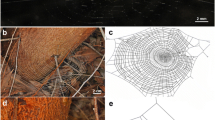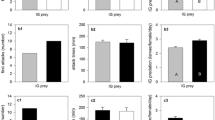Abstract
Infanticide, the killing of young, reproductively immature individuals of the perpetrator’s same species, has many interesting implications for reproductive fitness. Here we provide the first experimental description of infanticidal behavior in the passalid beetle Odontotaenius disjunctus (Illiger). To test our hypothesis that infanticide is triggered by the takeover of burrows by adults that had yet to reproduce in the mating season, we measured the mortality of larvae when housed with adults that were reproducing or had not yet reproduced. A significantly higher mortality was observed in larvae housed with adults that had not reproduced than when housed with their own parent or with unrelated reproducing adults. Infanticidal behavior of O. disjunctus is thought to result from the reproductive advantage obtained by taking over an existing burrow and thereby securing one with high food resource quality.

Similar content being viewed by others

References
Bartlett J (1987) Filial cannibalism in burying beetles. Behav Ecol Soc 21:179–184
Choe JC, Crespi BJ (eds) (1997) The Evolution of Social Behavior in Insects and Arachnids. Cambridge University Press, Cambridge, UK
Eggert AK, Sakaluk SK (2000) Benefits of communal breeding in burying beetles: a field experiment. Ecol Entomol 25:262–266
Elwood RW (1994) Temporal-based kinship recognition: a switch in time saves mine. Behav Proc 33:15–24
Gotch WE (1997) The behavior of the horned Passalus beetle, Odontotaenius disjunctus (Illiger). M.A. thesis, The College of William and Mary, Williamsburg
Gray IE (1946) Observations on the life history of the horned Passalus. Amer Midl Nat 35(3):728–746
Hare J (1996) Discrimination of nestmate larvae by the ant Leptothorax longispinosus. Can J Zool 74:2005–2060
Huerta C, Halfter G, Halfter V, López R (2003) Comparative analysis of reproductive and nesting behavior in several species of Eurysternus Dalman (Coleoptera: Scarbaeinae: Eurysternini). Acta Zool Mex 88:1–41
Hrdy SB (1979) Infanticide among animals: a review, classification, and examination of the implications for the reproductive strategies of females. Ethol Sociobiol 1:13–40
Mullen VT, Hunter PE (1973) Social behavior in confined populations of the horned passalus beetle (Coleoptera: Passalidae). J Ga Entomol Soc 8(2):115–123
Müller JK, Eggert AK (1990) Time-dependent shifts between infanticidal and parental behavior in female burying beetles: a mechanism of indirect mother-offspring recognition. Behav Ecol Sociobiol 27:11–16
Müller JK, Eggert AK (1997) Biparental care and social evolution in burying beetles: lessons from the larder. In Choe JC, Crespi BJ (eds) The evolution of social behavior in insects and arachnids. Cambridge University Press, Cambridge, UK, pp216–236
Müller JK, Eggert AK, Elsner T (2003) Nestmate recognition in burying beetles: the “breeder’s badge” as a cue used by females to distinguish their mates from male intruders. Behav Ecol 14(2):212–220
Pearse AS, Wharton GW, Ranking JS, Patterson MT (1936) The ecology of Passalus Cornutus fabricius: a beetle which lives in rotting logs. Ecol Monogr 6(4):455–490
Pluháčèek J, Bartoš L (2000) Male infanticide in captive plains zebra, Equus burchelli. Anim Behav 59:689–694
Schuster JC (1975) Comparative behavior, acoustical signals and ecology of New World Passalidae (Coleoptera). Ph.D. dissertation, University of Florida, Gainesville
Schuster JC, Schuster LB (1985) Social behavior in passalid beetles (Coleoptera: Passalidae): cooperative brood care. Fla Entomol 68(2):266–272
Schuster JC, Schuster LB (1997) The evolution of social behavior in Passalidae (Coleoptera). In Choe JC, Crespi BJ (eds) The evolution of social behavior in insects and arachnids. Cambridge University Press, Cambridge, UK, pp260–269
Scott MP (1998) The ecology and behavior of burying beetles. Annu Rev Entomol 43:595–618
Scott MP, Trumbo ST, Neese PA, Bailey WD, Roe RM (2001) Changes in biosynthesis and degradation of juvenile hormone during breeding by burying beetles: a reproductive or social role? J Insect Physiol 47:295–302
Sokal RR, Rohlf FJ (1995) Biometry: the principles and practice of statistics in biological research, 3rd edn. Freeman, New York
SPSS (2003) Version 12.0 for Windows. SPSS Inc., Chicago, IL
Suh SO, Marshall CJ, McHugh JV, Blackwell M (2003) Wood ingestion by Passalid beetles in the presence of xylose-fermenting gut yeasts. Mol Ecol 12(11):3137–3145
Trumbo ST (1990) Reproductive benefits of infanticide in a biparental burying beetle Nicrophorus orbicollis. Behav Ecol Sociobiol 27:269–273
Valenzuela-González J (1986) Territorial behavior of the subsocial beetle Heliscus tropicus under laboratory conditions (Coleoptera, Passalidae). Folia Entomol Mex 70:53–63
Acknowledgements
The authors would like to thank Dr. Stewart Ware, plant community ecologist at the College of William and Mary, for discussions concerning the College Woods, and Dr. Gisela Fashing for her critical review of the manuscript. A.J.K. was supported in this work by a grant from the William and Mary Howard Hughes Medical Institute Program.
Author information
Authors and Affiliations
Corresponding author
Rights and permissions
About this article
Cite this article
King, A., Fashing, N. Infanticidal Behavior in the Subsocial Beetle Odontotaenius disjunctus (Illiger) (Coleoptera: Passalidae). J Insect Behav 20, 527–536 (2007). https://doi.org/10.1007/s10905-007-9094-z
Published:
Issue Date:
DOI: https://doi.org/10.1007/s10905-007-9094-z



